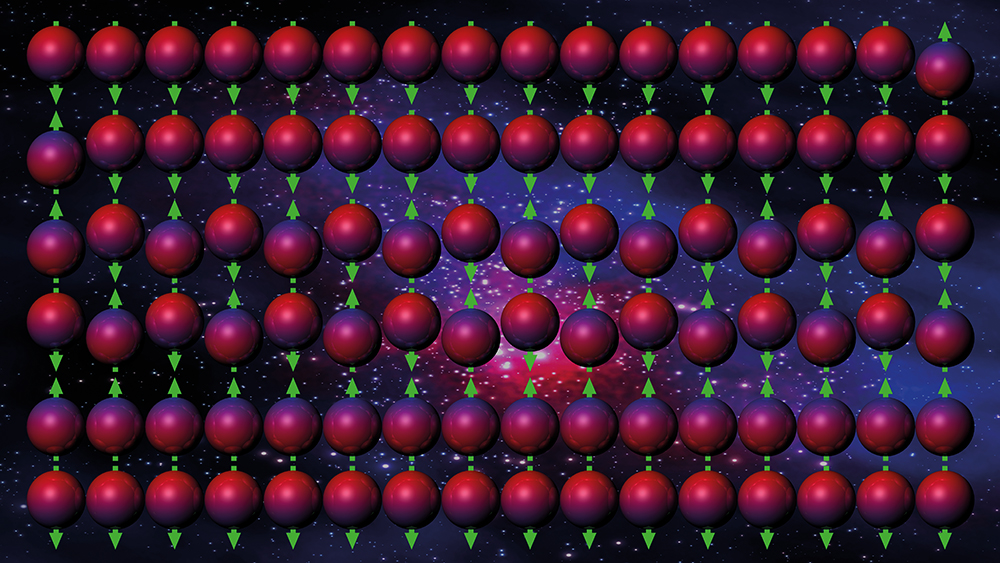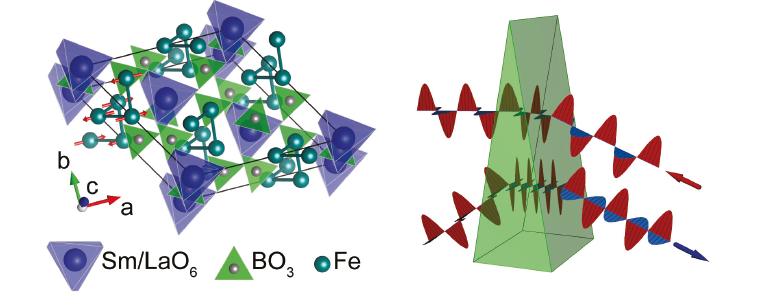Professor Andrei Pimenov – Controlling Light by Manipulating Electromagnons
Within some specialised materials, light can appear to move in mysterious ways, rotating around its direction of propagation, and becoming dimmed to different degrees, depending on its direction of travel. Professor Andrei Pimenov and his team at the Vienna University of Technology investigate how these properties are linked to recently discovered quasiparticles named ‘electromagnons’. The team’s work could soon open up new ways to consciously control the propagation of light within these unique solid materials, with numerous exciting technological applications.
Quasiparticles
Within a variety of solid materials, certain particles, such as electrons, can adopt disguises as they move around. Known as ‘quasiparticles’, these structures might appear to an observer to act like new particles with completely unique properties. However, since the behaviours of quasiparticles are simply a result of the influence of the surrounding ‘real’ particles they interact with, they remain completely within the bounds of the laws of physics.
Important for a variety of technological applications, quasiparticles represent a diverse family of structures, including phonons, plasmons, and fascinating phenomena called magnons.
Properties and Applications of Magnons
Among several other quantum properties, an individual electron possesses a value named its ‘spin’, which is analogous to the angular momentum of a rotating object on a quantum scale. Electron spins usually behave independently of one another, but in the right conditions, the spins of groups of electrons can be been collectively excited to the same energies using light. These collective spin excitations, known as magnons, have some interesting and potentially useful properties.
Magnons are commonly found in a class of materials named ferromagnets, in which the alignment of their constituent atoms’ magnetic properties means that they remain magnetised permanently. They also appear in other classes of materials, displaying properties called ferroelectricity and ferroelasticity; together, these three classes are named ‘ferroic’ properties. Within these materials – originally composed of iron as their name suggests – magnons can influence a variety of properties, including conductivity and heat transfer.
As techniques to study the properties of magnons improve, their potential applications are becoming increasingly apparent. In particular, they show promise in forming a basis for highly compact transistors, which carry out operations on collective excited electron spins. In addition, researchers are finding new ways to store information on these collective spins; opening up new routes towards highly compact hard drives.
However, through the use of increasingly specialised ferroic materials, Professor Andrei Pimenov and his team have discovered that magnons can display even more intriguing properties, pushing these potential applications to new limits.

Uncovering Evidence for Electromagnons
In 2006, Andrei Pimenov, then working at the University of Augsburg in Germany, carried out a novel series of experiments with ‘multiferroic’ materials, which display at least two of ferroic properties. Most commonly, these materials are both ferromagnetic and ferroelectric, meaning that both their magnetisation and the alignment of their constituent atoms, or ‘polarisation’, can be switched by applying magnetic and electric fields, respectively. These substances are particularly interesting since their magnetic properties, and their degree of polarisation in applied electric fields – or their ‘dielectric’ properties – are strongly linked, earning them the name ‘magnetodielectric’ materials.
In their study, Andrei Pimenov and his colleagues applied alternating electric fields across two different multiferroic materials: terbium manganite and gadolinium manganite. They found that the magnons present in these compounds could be excited and observed only if the spins of manganese ions were arranged in form of a spiral. However, when an external magnetic field was applied, which forced all manganese spins to become aligned parallel to the field, thus destroying the magnetic spiral, these magnons disappeared.
Since these unusual quasiparticles were excited by electric fields of light contrary to regular magnons, the researchers dubbed them ‘electromagnons’. In the coming years, they would become an important basis for Professor Pimenov’s research.
Anisotropy and Polarisation Rotation
One particularly mysterious property also arose in the magnetodielectric materials themselves. It was observed that the light propagating through the materials appeared to be asymmetrical – an effect named ‘directional anisotropy’. This meant that instead of propagating evenly, as would be the case within a regular block of uniform glass, two light beams travelling in opposite directions within a multiferroic material would be absorbed differently – being slowed down to different speeds. Indeed, the team showed that light can be completely stopped along one direction, and allowed to travel freely in the other, by fine-tuning the geometry of an external magnetic field.
In several other studies, Andrei Pimenov’s team also explored changes in linearly polarised light, whose constituent fields vibrate in one specific direction, as it travels through multiferroic substances. They found that regardless of the frequency of the light, the direction of this polarisation will rotate around the light’s direction of travel. Furthermore, just as the anisotropy of a magnetodielectric material can be tuned using an external magnetic field, the researchers discovered that both the amplitude and direction of this polarisation direction can be tuned using an external electric field.

Manipulating Excitation
Having demonstrated these capabilities for optical property manipulation using external fields, Andrei Pimenov and his colleagues next aimed to show how they could be used to influence the behaviours of electromagnons.
In their initial experiments, the team did not know enough about the properties of electromagnons to explore how they could be formed under different conditions. However, in further studies, they realised that external electric and magnetic fields can alter the frequencies at which the quasiparticles become excited. Shifting the frequencies of magnetic processes in this way is a key barrier to overcome for many experiments in materials physics, especially those with applications in electronics.
In this case, the physicists were able to identify a series of magnetic vibrations within the constituent molecules of a particular class of multiferroics named iron borates, which were sensitive to both electric and magnetic fields at the same time. This sensitivity arose because the directions of the magnons’ collective electron spins were modified by the fields. In turn, this altered the characteristic frequencies at which the magnons were excited.
Having uncovered this mechanism, Professor Pimenov’s team could finally excite electromagnons within magnetodielectric materials, at the terahertz frequencies they required for their experiments.
Controlling Light with Electromagnons
At the same time as these studies, Professor Pimenov and his colleagues explored the reverse situation: how electromagnons themselves could be used to influence the properties of external fields. Their previous studies had already revealed an intrinsic coupling between the quasiparticles and external electric and magnetic fields, which themselves were shown to influence polarisation rotation and anisotropy, respectively. Therefore, the next logical step in this line of research was to use electromagnons to precisely control the properties of light passing through magnetodielectric materials. In the final step of this puzzle, the physicists investigated how the characteristics of electromagnons in magnetodielectric materials were linked to these properties.
Andrei Pimenov’s team discovered that variations in both anisotropy and polarisation rotation showed substantial responses close to the resonant frequencies of electromagnons – the frequencies at which the electron spins collectively display the strongest responses to external electric and magnetic fields. Specifically, the researchers observed that the ‘transmission coefficient’ of magnetodielectric materials – the total power of waves that have passed through, in proportion to the waves that first entered – began to differ hugely in forward and backward directions, in the vicinity of these frequencies.
In addition, linearly polarised light entering the materials rotated by an angle proportional to a value called the ‘magnetoelectric susceptibility’, which describes how the material becomes electrically polarised in response to a magnetic field, and vice versa. Again, the team observed that the angles become larger close to electromagnon resonance frequencies.
By fine-tuning the properties of their electromagnons using external fields, and through careful selection of multiferroic composition, the researchers were able to demonstrate high degrees of control over the light traveling through magnetodielectric materials. This highlights that since their discovery in 2006, electromagnons have gone from being a mysterious new type of quasiparticle, to a well-understood and useful tool for controlling the propagation of light.

A Bright Future
The work of Professor Pimenov and his colleagues has now broken down many of the mysteries surrounding the unusual properties of magnetodielectric materials, and the electromagnons they contain. The ability to control the polarisation rotation and propagation asymmetry of light travelling through the materials could have incredibly useful optical applications, providing new opportunities for experiments and technologies alike.
In particular, more sophisticated techniques for control using electromagnons could open up new and innovative routes towards highly compact transistors and data storage devices in quantum computers in the near future. For now, Andrei Pimenov’s team will continue to explore the rich variety of intriguing properties observed in multiferroics and other magnetodielectric materials, and will aim to learn more about the unusual behaviour of electromagnons.
Reference
https://doi.org/10.33548/SCIENTIA404
Meet the researcher

Professor Andrei Pimenov
Institute for Solid State Physics
Vienna University of Technology
Vienna
Austria
Professor Andrei Pimenov studied physics at Moscow Institute of Physics and Technology, and received his PhD degree from the Technical University of Darmstadt in 1995 for a dissertation on dynamic conductivity of superconductors using contact-free methods. In 2001 he did his Habilitation in experimental physics with the title ‘Submillimetre-Wave Electrodynamics of Superconductors’ at the University of Augsburg. In 2006, he became Associate Professor at the University of Würzburg, where he worked until 2010. He is now a full Professor at the Vienna University of Technology, where he leads the Solid-State Spectroscopy group. Here, he is also the Director of the Institute for Solid State Physics. Professor Pimenov has authored more than 120 papers in several fields of solid-state physics, spectroscopy and metamaterials. He is married and has two children.
CONTACT
E: andrei.pimenov@ifp.tuwien.ac.at
W: https://www.ifp.tuwien.ac.at/spectroscopy/research/
FURTHER READING
AM Kuzmenko, V Dziom, A Shuvaev, A Pimenov, D Szaller, AA Mukhin, VY Ivanov, A Pimenov, Sign change of polarization rotation under time or space inversion in magnetoelectric YbAl3(BO3)4, Physical Review B, 2019, 99, 224417.
AM Kuzmenko, D Szaller, T Kain, V Dziom, L Weymann, A Shuvaev, A Pimenov, AA Mukhin, VY Ivanov, IA Gudim, LN Bezmaternykh, Switching of magnons by electric and magnetic fields in multiferroic borates, Physical Review Letters, 2018, 120, 027203.
AM Kuzmenko, V Dziom, A Shuvaev, A, Pimenov, M Schiebl, AA Mukhin, VY Ivanov, IA Gudim, LN Bezmaternykh, A Pimenov, Large directional optical anisotropy in multiferroic ferroborate, Physical Review B, 2015, 92, 184409.
A Shuvaev, V Dziom, A Pimenov, M Schiebl, AA Mukhin, AC Komarek, T Finger, M Braden, A Pimenov, Electric field control of terahertz polarization in a multiferroic manganite with electromagnons, Physical Review Letters, 2013, 111, 227201.
A Pimenov, AA Mukhin, VY Ivanov, VD Travkin, AM Balbashov, A Loidl, Possible evidence for electromagnons in multiferroic manganites, Nature Physics, 2006, 2, 97.

Creative Commons Licence
(CC BY 4.0)
This work is licensed under a Creative Commons Attribution 4.0 International License. 
What does this mean?
Share: You can copy and redistribute the material in any medium or format
Adapt: You can change, and build upon the material for any purpose, even commercially.
Credit: You must give appropriate credit, provide a link to the license, and indicate if changes were made.
More articles you may like
Dr Lifei Wang | Can Species Distribution Models Inform Us About Future Ecosystems?
The world is buzzing with news about how human activities and climate shifts are reshaping our ecosystems. Have you ever wondered how life will adapt to this rapidly changing world? Ecologists might be able to predict how different species will live in future using computer simulations. Dr Lifei Wang at the University of Toronto Scarborough investigates how different stimulations work under varying conditions to provide new insights into what may lie ahead.
Dr Yong Teng | Improving the Outlook for Head and Neck Cancer Patients
Dr Yong Teng at the Emory University School of Medicine is working with colleagues to overcome the high mortality of individuals diagnosed with cancers affecting the head and neck. One of his approaches is based on understanding the particular mechanisms of the ATAD3A gene, which new insights suggest are closely related to cancers affecting the head and neck.
Dr Tsun-Kong Sham – Dr Jiatang Chen – Dr Zou Finfrock – Dr Zhiqiang Wang | X-Rays Shine Light on Fuel Cell Catalysts
Understanding the electronic behaviour of fuel cell catalysts can be difficult using standard experimental techniques, although this knowledge is critical to their fine-tuning and optimisation. Dr Jiatang Chen at the University of Western Ontario works with colleagues to use the cutting-edge valence-to-core X-ray emission spectroscopy method to determine the precise electronic effects of altering the amounts of platinum and nickel in platinum-nickel catalysts used in fuel cells. Their research demonstrates the potential application of this technique to analysing battery materials, catalysts, and even cancer drug molecules.
Dr Michael Cherney – Professor Daniel Fisher | Unlocking Woolly Mammoth Mysteries: Tusks as Hormone Time Capsules
The impressive tusks found on proboscideans (the order of mammals that includes elephants, woolly mammoths, and mastodons) are like time capsules, preserving detailed records of their bearers’ lives in the form of growth layers and chemical traces. Frozen in time for thousands of years, these layers can unlock secrets about the lives of long-extinct relatives of modern elephants. Dr Michael Cherney and Professor Daniel Fisher from the University of Michigan used innovative techniques to extract and analyse steroid hormones preserved in woolly mammoth tusks. This ground-breaking work opens new avenues for exploring the biology and behaviour of extinct species.




